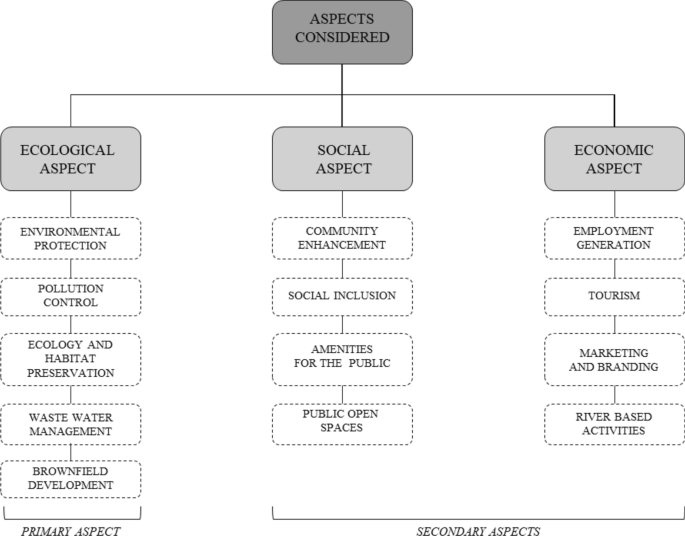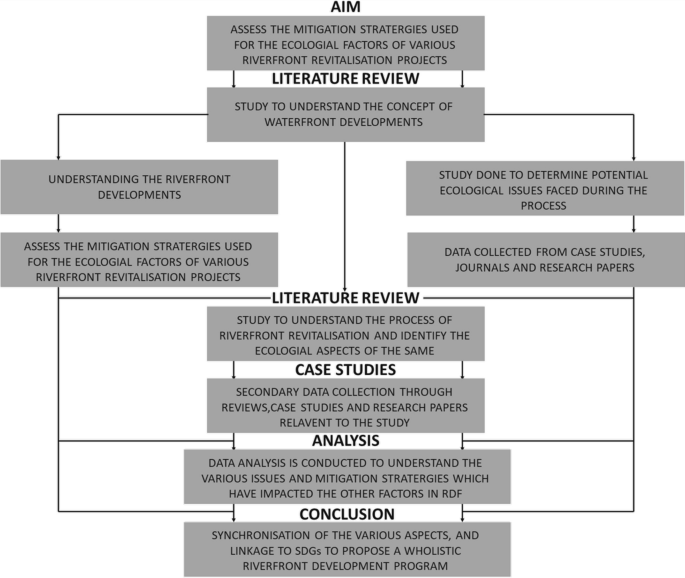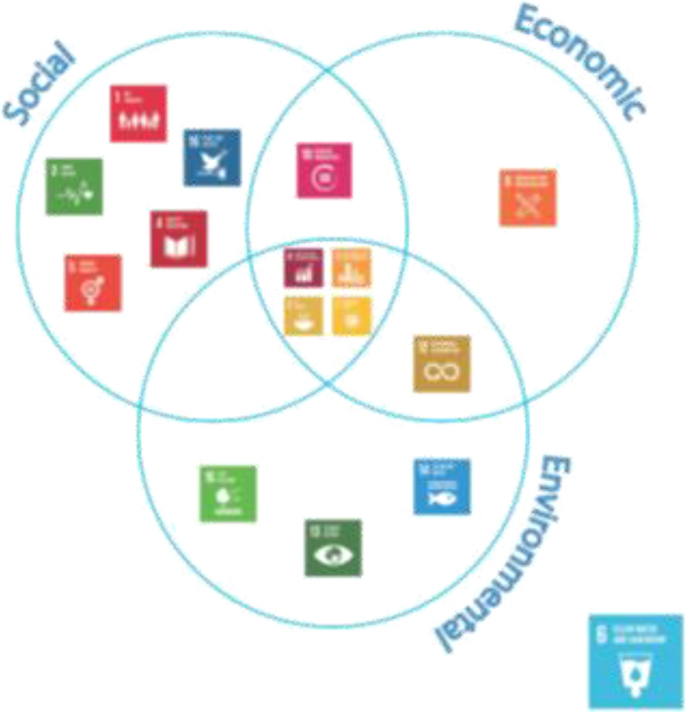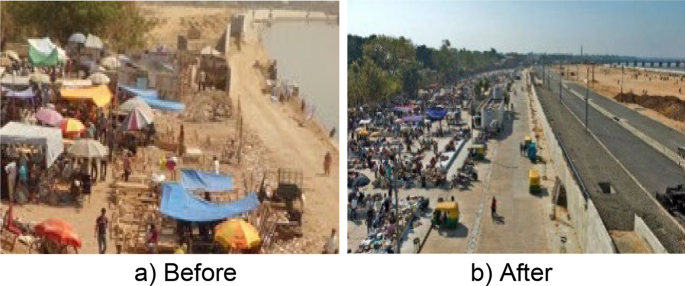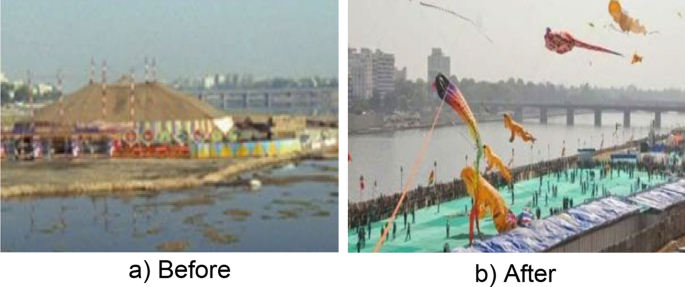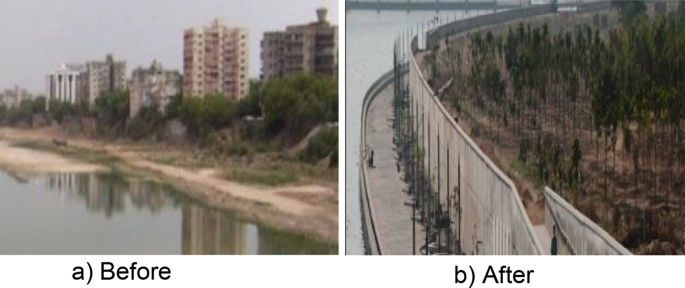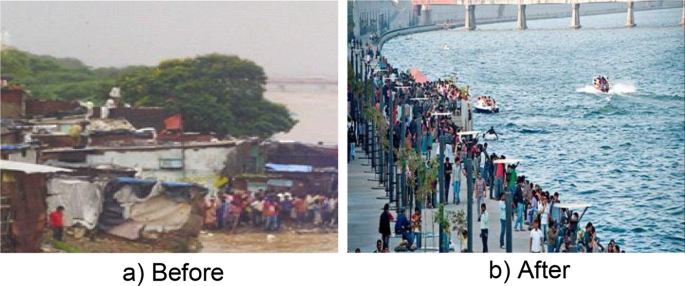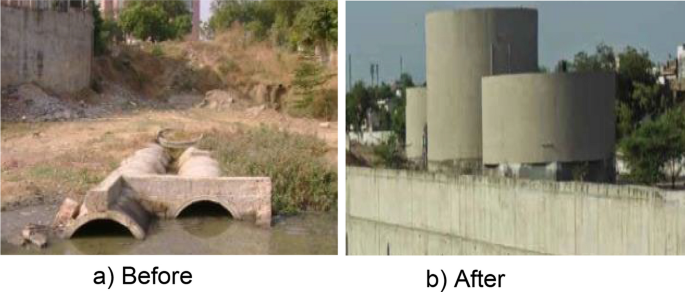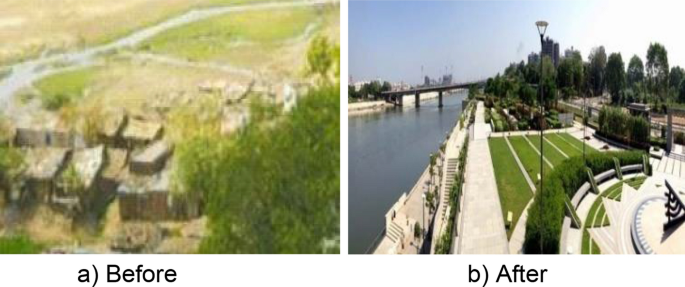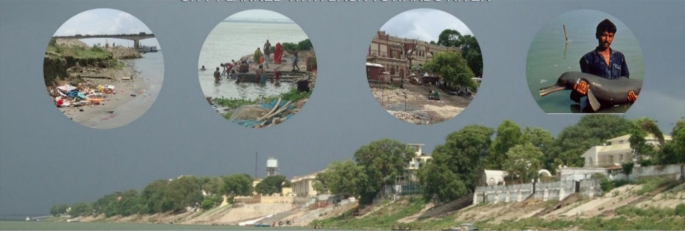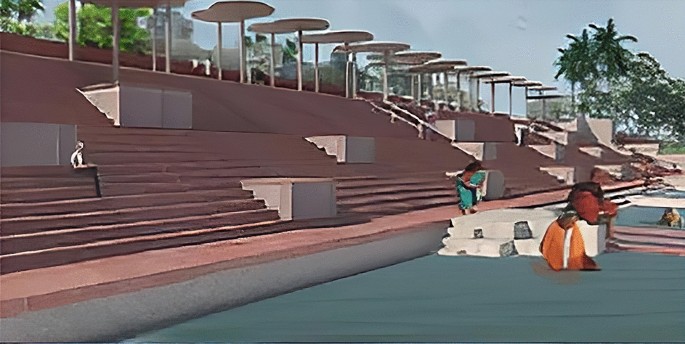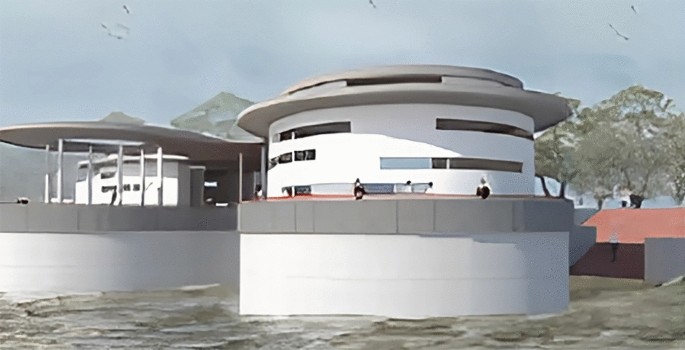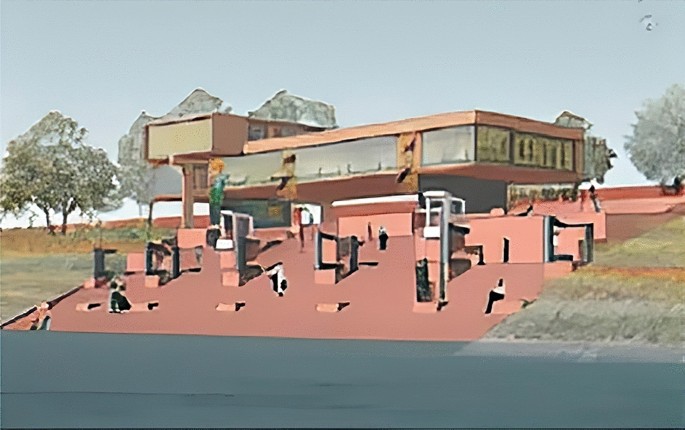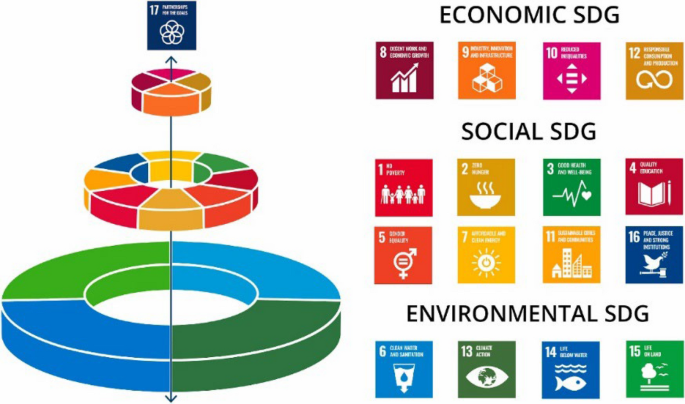Abstract
Urban waterfronts have evolved into vibrant centres of recreation, tourism, and economic activities, becoming focal points for social, cultural, and religious gatherings in modern cities. The historical development of riverfronts sought to elevate the economic status and image of neighbouring cities during the industrial era. However, with the growing emphasis on riverfront revitalization projects in recent times, it has become imperative to prioritize environmental sustainability and ecological considerations in the planning and execution of these initiatives. This paper delves into the revitalization plans of the Sabarmati and Patna riverfronts in India, undertaking a comparative assessment of their development strategies and challenges encountered in ecological preservation. The study seeks to explore the interplay between the river and environmental concerns and analyse the positive impacts of ecological improvements on the social and economic dimensions of these urban waterfronts. Additionally, the research scrutinizes the alignment of these various aspects with the United Nations' Sustainable Development Goals, presenting an integrated approach towards fostering holistic and sustainable urban riverfront development. The study on riverfront development projects revealed that successful projects prioritize social inclusivity, economic vitality, and environmental sustainability, contributing to the long-term success and well-being of both communities and ecosystems. The research demonstrates the potential for holistic and sustainable urban development through riverfront revitalization, offering valuable insights and case studies for future urban redevelopment projects.
Similar content being viewed by others
Avoid common mistakes on your manuscript.
1 Introduction
Rivers have been a lifeline for human civilization since ancient times, providing fertile lands, water, and transportation through valleys (Vriddhi, 2017). In earlier times, horses and carts were the primary means of transportation along those riverbanks. However, factories and warehouses emerged along the riverbeds during the industrial revolution, dumping pollutants into the once-pristine waters (Chakrabortty et al., 2022; Slathia & Jamwal, 2022). As roads expanded during this period, the need for boats dwindled, and those factories moved to central parts of cities. Unfortunately, as Roy Cloutier observed, little was done to repurpose those old warehouses, and they fell into disuse. In the Indian context, the evolution of urban riverfronts followed a similar trajectory, with sociocultural and religious factors included (Vimawala, 2015).
The history of riverfronts in India can be divided into four categories: the early stage, which focuses on the initial civilizations such as the Indus Valley civilization; the mythological period from 3000 BC, which led to settlements by various groups, including the Mughals, Portuguese, Dutch, French, and the British; the preindependence stage from the thirteenth century to the twentieth century, which saw an increase in industries; and finally, the postindependence stage from the twentieth century onwards, where a steady degradation of riverfronts is observed (Garg & Anand, 2022; Vimawala, 2015). Throughout this development, rivers in India have been held in spiritual esteem and respected as providers among many Indians, making it a daunting task for planners to balance local and global perspectives. In addition to being cultural and religious hubs, rivers are integral to urban life. Riverfront imaginings have been priceless for architecture, settlements, and public spaces. For example, the Taj Mahal, an architectural marvel on the banks of the Yamuna River, still stands as an identity for India. Hence, rivers and their respective developments play a crucial role in encapsulating vital imagery of any city. Human intervention has adversely impacted riverfront areas, leading to indiscriminate raw waste and sewage dumping on these water fronts (Chen et al., 2022). As a result, rivers have become a dumping ground for all undesirable activities, posing unprecedented environmental challenges. However, in the last decade, significant efforts have been made to restore these water-front areas, bringing them back to life and reviving their beauty (Zhang et al., 2022).
The Indian government has taken on a massive urban redevelopment mission, known as the National Smart City Mission, to elevate the quality of life for its citizens. This ambitious project aims to enhance the livability of various cities across India and make them more user-friendly. The riverfront development project is a critical part of this mission, which aims to connect the linear waterfront with public spaces, protect natural riverfront development, and restore the city's identity (Vercruysse et al., 2022). The Planning Tank has reported that improving these riverfront projects has directly influenced the positive well-being of the city's residents, which is an excellent sign of progress.
To achieve a better and more sustainable future, the United Nations has also set up Sustainable Development Goals that aim to create frameworks for sustainable development. While ecological aspects have been given exclusive importance in these programmes, users' social, economic, physical, and psychological aspects have been neglected (Khan et al., 2022; Singh et al., 2022). However, it is essential to consider all these factors while devising riverfront development plans, as they significantly impact the quality of life of the city's residents (Paonam & Chatterjee, 2022). In today's fast-paced world, the urban lifestyle has become the norm, leading to the need for more user-friendly and liveable cities. Thus, the National Smart Cities mission launched by the Indian government to revamp cities across the country, with riverfront development projects playing a pivotal role, would help enhance citizens' liveability. However, while ecological factors have been given importance, the social, economic, physical, and psychological aspects have been side-lined in developmental programmes. Addressing the missing points in environmental policymaking is crucial for achieving effective and sustainable solutions (Srinivas et al., 2020). While some policymakers acknowledge the need for policy interventions, comprehensive and actionable policy recommendations are often lacking, limiting their practical implementation by policymakers and stakeholders. Additionally, focusing solely on ecological aspects without delving into the social and economic dimensions related to environmental challenges hinders the development of holistic and inclusive strategies. Moreover, the absence of longitudinal studies limits insights into long-term environmental changes, trends, and the lasting impacts of human activities on ecosystems. Integrating social, economic, and policy aspects, along with conducting longitudinal studies, can enhance the robustness and applicability of the environmental policies created, leading to more sustainable and impactful solutions for the challenges we face.
The paper's objective is to understand the interlinkage between the different aspects of riverfront development using data from case studies and surveys. This analysis revealed the need for a more holistic approach to synchronize all aspects of riverfront development. Therefore, this study aims to examine the impact of ecological development on the social and economic facets of riverfront revitalization projects in India (Ahirrao & Khan, 2022). The present study analyses the driving forces behind riverfront redevelopment, particularly the ecological aspect. It identifies the linkage between all three facets of riverfront development, ecological, social, and economic, to achieve a more holistic design approach, an aspect that was lagging, especially in studies related to the Indian context. This study examines this important aspect with reference to Indian riverfront revitisation projects. The Sustainable Development Goals framework analyses the linkage between each aspect to support the study. In addition, the study closely examines the various attributes considered for each aspect. Figure 1 indicates the various aspects considered in the study. The analysis will provide insights into the impact of ecological development on India's social and economic uplift of riverfront development (Bozdağ, 2022). The riverfront development project is a much-needed initiative to enhance the livability of Indian cities. A more holistic approach that considers all aspects of riverfront development is essential to achieve a sustainable and better future for all.
2 Research methodology
This methodology aims to assess the environmental impacts and promote sustainable development in riverfront development projects. The research acknowledges the importance of addressing missing points in environmental research, including comprehensive policy recommendations, social and economic dimensions, and longitudinal studies. Figure 2 represents the methodology adopted for the study.
Data collection: A mixed methodology approach is employed, combining qualitative and quantitative methods. For the quantitative aspect, existing datasets from journals, government archives, and surveys with 20 questions are collected. Qualitative analysis will involve examining existing studies from journals and government archives. Content analysis will categorize and discuss key points, phrases, and words that emerge during the study.
Environmental impacts: The data analysis will establish linkages between identified environmental impacts and secondary attributes of riverfront development. Longitudinal studies will be used to understand long-term changes and trends in environmental conditions, enabling a comprehensive evaluation of the lasting effects of human activities on ecosystems.
Social and economic dimensions: This research delves into the social and economic aspects related to environmental challenges in riverfront development. It will explore the interconnections between ecological, economic, and social impacts, ensuring a holistic understanding of the projects' implications on the quality of life of city residents.
Interconnections with sustainable development goals: This study will analyse how riverfront development projects align with the United Nations' Sustainable Development Goals (SDGs). Identifying connections between the projects and SDGs will contribute to a broader vision of sustainable urban development.
Holistic approach: By integrating social, economic, and policy aspects and conducting longitudinal studies, this methodology will offer a comprehensive and informed analysis of riverfront development projects. The research findings will contribute to more sustainable and impactful solutions, guiding policymakers and stakeholders towards effective riverfront development that balances ecological preservation and social well-being for a better and more sustainable future (Majumdar et al., 2023).
3 Background of the study
For centuries, civilizations have thrived along the banks of rivers and water bodies, creating several port cities worldwide. These waterfronts have become public spaces that engage the community and promote maritime commerce, bringing together the waterline and the city (Vercruysse et al., 2022). However, planning these water-front spaces requires understanding the planning and development process, including the perception and inclusion of propelling bodies. In the present-day planning scenario, people's perception and inclusion of propelling bodies are essential factors missing from the planning process (Ahirrao & Khan, 2022; Sekhar & Raina, 2021). It is essential to cater to the psychological needs of the people and consider various social issues in riverfront development programmes. Roy Cloutier's study of designing water-front access to public spaces emphasized that physical and psychological factors are the most critical barriers to redesigning degraded water fronts (Wu et al., 2021). While designing riverfront development projects, comprehensive frameworks and guidelines must be considered. These guidelines can help designers create water-front properties more holistically and lead to the development of cities' social, economic, and physical conditions (Bozdağ, 2022). However, it is essential to consider the sociocultural aspects of rivers in an Indian context. Each river in India has a unique cultural aspect, and in addition to ecological importance, each river serves as a social and economic lifeline to the surrounding communities. A survey of 20 questionnaires helped gain insight into people's perceptions of the present-day riverfronts. Most users who lived near the rivers rarely visited these waterfronts. On enquiring about this situation, the users felt that water quality degradation, safety issues, and lack of social spaces and infrastructure are significant reasons to avoid riverfronts (Khan et al., 2022). Accessible walkways and promenades with the landscape, demarcated social spaces, pollution of the river, and commercial and recreation spaces are some of the aspects that can create an ideal riverfront. Hence, most users feel that improving the place's overall ecology can help improve the overall sociocultural and economic aspects (Bozdağ, 2022). The revitalization of the social and economic forefront is also essential, along with the ecological sustenance of the river. It is crucial to understand that the river is not just an ecological but also a cultural resource that must be protected (Wu et al., 2021). By incorporating the sociocultural aspects of rivers and considering people's needs, riverfront development can be more holistic and engaging for the community (Ahirrao & Khan, 2022).
3.1 Review of the literature
The research papers reviewed as a backtrack exhibited a strong focus on assessing the environmental impact of various activities on riverfronts. These studies delve into the effects of factors such as pollution, urbanization, agriculture, and quarrying on different ecosystems and natural resources. By thoroughly analysing these impacts, a comprehensive understanding of the environmental challenges facing riverfronts and other areas was noted. A common approach used in these papers is the utilization of water assessment methods. These served as valuable tools for quantifying the environmental impact and ecological health of water bodies. This standardized approach enhances the accuracy and objectivity of environmental assessments (Begum et al., 2022). Moreover, the inclusion of case studies in many research papers adds practical relevance to their findings. These case studies focus on specific regions or river basins, providing real-world insights into the challenges faced and potential solutions(Ravindra et al., 2022). By examining the environmental conditions, the impacts of human activities, and the responses to conservation efforts in these case studies, researchers can draw valuable lessons applicable to similar scenarios worldwide. Overall, the assessment of environmental impact and the inclusion of case studies contribute to the robustness and applicability of the research papers. These elements enhance the understanding of the complexities involved in riverfront development and environmental management. By embracing a data-driven and real-world approach, researchers and policymakers can work together to develop more effective strategies for sustainable riverfront development and environmental conservation.
4 United nations sustainable development goals
As per the United Nations, sustainable development goals were formulated to provide a common ground for sustainable development. The primary SDG selected for the basis of the study is goal 6.
4.1 Goal 6-clean water and sanitation
Mission: Ensure availability and sustainable management of water and sanitation for all.
As per the United Nations (United Nations (UN) Water, 2018), Goal 6 under the SDGs mainly aims to access safe drinking water and sanitation facilities for all concerned. The primary six targets to achieve this goal include the following: safe and affordable drinking water, ending open defecation and providing access to sanitation and hygiene, improving water quality, wastewater treatment and safe reuse, increasing water-use efficiency, ensuring freshwater supplies and protecting and restoring water-related ecosystems. One of the main aspects the United Nations considers for SDG 6 is the IWRM system, a process that promotes the coordinated development and management of water, land, and related resources to maximize the resultant economic and social welfare equitably without compromising the sustainability of vital ecosystems (Vercruysse et al., 2022). As per UNESCO's synthesis report on SDG 6 in 2018, there is an overall interlink between the SDG targets as shown in Fig. 3 related to governance and policy settings.
Involvement in managing water resources while using integrated water resource management principles with overall benefits for poverty reduction is presented in what can be considered the "software" of the water resource management system. On the other hand, the interlinkages between SDG targets related to providing access to and supplying clean water and proper wastewater disposal and management in an urban and rural environment with critical importance for human health are considered the "hardware" of the water resources management system. Targets for improving water quality by reducing pollution and untreated wastewater, eliminating dumping, and minimizing the release of hazardous chemicals and materials are essential to leveraging points in this system's interlinkage model. This shows that utilizing wastewater for energy generation through innovation creates decent jobs and general economic growth. Hence, in assessing the linkages, synergies and trade-offs, it is essential to understand the codependency of SDGs. For example, water quality will drastically improve by increasing water sanitation and hygiene, reducing pollution and increasing human well-being. Many SDGs cannot be achieved without meeting the targets offered by this SDG, making it one of the essential SDGs to be achieved. The secondary SDG selected for the basis of the study is goal 14.
4.2 Goal 14-life below the water
Mission: Conserve and sustainably use the oceans, seas, and marine resources for sustainable development.
As per the United Nations, Goal 14 under the SDGs mainly aims to regulate the overexploitation of fish and other marine life and prevent destructive fisheries practices to restore the fish stock quickly to produce maximum sustainability. Water bodies, especially the coastlines and riverfronts in India, support the adjacent region's overall social, economic, and ecological needs. Hence, achieving these goals to promote the social, economic, and ecological dimensions is essential. The primary outcome-oriented targets to achieve this goal include the following: reducing marine pollution; protecting and restoring ecosystems, sustainable fishing, conserving coastal and marine areas, and ending subsidies contributing to overfishing; increasing the economic benefits from the sustainable use of marine resources and increasing scientific knowledge, research and technology for ocean health; supporting small-scale fishers as per the synthesis report by UNESCO in 2018; and achieving SDG 14 concerning riverfronts directly linked to achieving SDG 1-Zero Hunger, SDG 2-Health and well-being and SDG 3 Decent work and economic growth.
4.3 Goal 15-life on land
Mission: Protect, restore, and promote sustainable use of terrestrial ecosystems, sustainably manage forests, combat desertification, halt and reverse land degradation and halt biodiversity loss.
As per the United Nations, SDG 15 mainly articulates targets for preserving the biodiversity of forests and all ecosystems on the landmass. Conservation and restoration of freshwater ecosystems are essential for achieving the SDGs. The primary outcome targets to be achieved when considering riverfront development are conserving and restoring terrestrial and freshwater ecosystems and deforestation. It also aims to restore degraded forests, end desertification and degraded land, prevent invasive alien species on land and in water ecosystems, and integrate ecosystem and biodiversity in governmental planning. SDG 15, as per UNESCO, is mainly linked with the socioeconomic SDGs: SDG 6, SDG 12 and SDG 11.
5 Case studies
The various aspects of riverfront development, environmental concerns and sustainability are studied. The riverfront development proposals of the Sabarmati River in Ahmedabad, Gujarat, India, and the Ganga River in Patna, Bihar, India, are compared for their development strategies and the challenges they have faced in ecological preservation as case studies.
5.1 Sabarmati riverfront development
The Sabarmati Riverfront Development is an ambitious and highly lauded project located in Ahmedabad, a bustling metropolis in the Indian state of Gujarat. This magnificent project was first proposed in the 1960s but only came to fruition in 2005, with ongoing construction still occurring today. The Sabarmati Riverfront is a site of great cultural significance, as it was here that Mahatma Gandhi established the Sabarmati Ashram during India's freedom struggle. The river is one of India's major west-flowing rivers, originating in the Aravalli Ranges of Udaipur in Rajasthan before flowing for a distance of 371 km and finally emptying into the Gulf of Khambhat in the Arabian Sea. The Sabarmati River has a total catchment area of 21,674 km2, of which 4124 km2 is located in Rajasthan and 18,550 km2 is in Gujarat. The Sabarmati Riverfront Development project is a game changer for the city of Ahmedabad, and it is quickly becoming one of the most sought-after tourist destinations in India. This exciting project offers a range of engaging facilities and attractions for visitors, including parks, gardens, and promenades. The project has also led to the construction of several iconic structures, such as the Sabarmati Riverfront Flower Park and the Sabarmati Riverfront Fountain Park, which serve as a testament to the city's commitment to urban development and sustainability. The Sabarmati Riverfront Development project is an awe-inspiring achievement that has transformed Ahmedabad into a vibrant and dynamic city and continues to inspire other urban centres worldwide. However, before the project's development, the Sabarmati Riverfront was neglected and polluted due to the overpopulation of illegal encroachments and informal economic practices such as the Sunday flea market known as the ravivari market. This led to a significant decline in the quality of the riverfront, and it became a site that could only be viewed from the bridge. As a result, the Ahmedabad Municipal Corporation established the Sabarmati Riverfront Development Corporation Limited (SRFDCL) as a special-purpose vehicle to rejuvenate the Sabarmati Riverfront and create a dynamic, meaningful water-front environment. The masterplan of the proposal is presented in Fig. 4. As per the Ahmedabad Municipal Corporation and the Gujarat pollution control board, the main objectives of this project were.
Sabarmati Riverfront master plan (Amirtahmasebi et al., 2016)
Environmental improvement: Reduce erosion and floods to safeguard the city and sewage diversion to ensure water retention.
Social upliftment: Activities are proposed in parks and gardens as spaces to provide sociocultural spaces.
Sustainable development: Generation of resources and revitalization of neighbourhoods to bring a new life to the city. The entire motion for riverfront development was triggered by the excessive pollution found in the river.
The leading causes of water contamination were as follows:
Disposal of sewage and waste along the riverbed: As per the Gujarat pollution control board, up to 168 MLD (million litres per day) of untreated sewage is released into the Sabarmati River per day, leading to an overall increase in the BOD to 30.14 ppm, which is six times the standard value, and an increase in COD to 1535 mg/l. The overall increase in BOD and COD has decreased oxygen demand, affecting the aquatic ecosystem (Haldar et al., 2014).
Illegal encroachment: As per the Ahmedabad Municipal Council census, the Sabarmati Riverfront has more than 10,000 families illegally living on the banks. The main reasons are poverty and drastic urban growth within the city; however, these illegal encroachments significantly impact the adjoining water body. The lack of proper facilities and services has forced settlers to dispose of their waste, including open defecation over the riverbed. In addition, the lack of space and proper infrastructure has led to the haphazard setup of spaces such as Sunday informal flea markets, the Dhobi ghat and event areas. Haphazard planning of these spaces has led to carelessness and disposal of waste along the riverbed (Paneria, 2017).
5.2 Strategies used by the SRFDCL
The SRFDCL has mainly used two strategies to combat primary environmental issues.
Improving the water management system: The integration of water retention in the Sabarmati River by the SRFDCL for almost a year helped improve water system management, especially during rains.
Improvement of the sewage disposal system: The overall redevelopment plan by the Gujarat pollution control board included incorporating three more sewage treatment plants with a capacity of 20.5 MLD to combat the increasing level of pollution in the river. In addition, drainage pumping stations, sewage treatment plants, interceptors for effluents and sewerage were also set up. New drainage lines replaced the old ones to ensure better system functionality. This overall contribution to the ecological development of the riverfront has directly impacted the social uplift of the area (Paneria, 2017).
5.3 Social and economic impact
The impact of this redevelopment project on the social and economic aspects is discussed below.
5.3.1 The Gujjari Bazar (Ravivari Market)
The informal Sunday market below the Ellis Bridge bought in many people weekly. A lack of proper planning left the area poor after Bazar (Fig. 5a). To combat this, designers created a permeable concretized site with formal seating spaces for vendors and adequate waste disposal techniques to avoid further pollution of the riverbed. Trash and masonry bins were set up across the promenade to ensure that the waste disposed of in the flea market was done correctly. The overall improvement in waste disposal has directly improved the quality and experience within the Gujjari market, hence receiving a more significant influx of users and improving the overall economic activity within the area (Fig. 5b).
Gujjari market (Paneria, 2017)
5.3.2 Dhobi Ghat
Sabarmati has a large Dhobi Ghat on the banks; however, due to improper drainage and disposal, the graywater from the Ghat would directly flow into the river (Fig. 6a). The redevelopment project has created a formal space with proper seating and washing areas to ensure the sustenance of these ghats (Paneria, 2017). These improvements have helped improve the social quality of the ghats (Fig. 6b). Before development, clothes were washed and dried on the riverbanks, resulting in water quality deterioration. Redevelopment has contributed to improving the social/economic status of the Dhobi community.
Dhobi Ghat (Paneria, 2017)
5.3.3 Event area
The dry bed area hosts several events, such as circuses and fairs; however, mismanagement leads to the direct contribution of pollution to the riverfront (Fig. 7a). Hence, this area was converted into a space with pathways and pavements to ensure systematic use, which directly prevents the exploitation of the river. The improvement in this area's environmental quality has directly promoted several social activities and has led to the social inclusion of several communities and activities. As per the Ahmedabad Municipal Council, one of the significant social events is the kite festival, which serves as a basis for community enhancement and promotes economic activity among hawkers and vendors (Fig. 7b).
Event area (Paneria, 2017)
5.3.4 Urban forestry
A unique afforestation project of 1 lakh square metres was also promoted between the Vasna and Ambedkar bridges (Fig. 8a), mainly with indigenous species to Gujarat, promoting the area's flora and fauna. Over 10,000 trees were planted along the promenade to ensure afforestation within the Sabarmati area (Paneria, 2017). The entire planning process in this area has created several public open spaces and amenities. It has also enhanced the area covered by urban forestry (Fig. 8b).
Forestry (Paneria, 2017)
5.3.5 Promenade
Before the riverfront's development, the banks were occupied with dwellings, leading to slum creation in several areas along the riverfront, as depicted in Fig. 9a. These encroachments impacted the riverfront and, subsequently, the river's ecological condition due to the lack of proper sanitation and waste disposal facilities. It created a negative connotation along the riverfront. After redevelopment, the promenade played a key role in offering a recreational and leisure space for residents and visitors, as shown in Fig. 9b. It features well-paved walkways, landscaped gardens, and seating areas, providing an inviting environment for people to stroll, exercise, and enjoy the picturesque views of the river and the cityscape. The promenade's development has not only enhanced the aesthetic appeal of the riverfront but also transformed it into a vibrant social and cultural hub, fostering community engagement and promoting sustainable urban living.
Promenade (Paneria, 2017)
5.3.6 Sewage treatment plants
Due to the increase in industrial and domestic waste products, the existing sewage treatment plants could not keep up with the ever-increasing influx of waste treatment. Pollution was one of the main reasons for the quality degradation on the riverfront (Fig. 10a). The increase in pollutants in the river directly leads to an increase in oxygen-dependent microorganisms that harm the river's aquatic life. Hence, to combat this issue, additional STPs were proposed along the banks of the river. This method helped significantly reduce the domestic and industrial untreated wastewater expelled into the river, reducing the river's BOD and COD. The introduction of the treatment plants by the Gujarat Pollution Control Board significantly improved water quality, as shown in Fig. 10b. This has leveraged the community's social benefits and upgraded users' health and sanitation.
Sewage disposal (Paneria, 2017)
5.3.7 Public gardens and parks
Approximately 27% of the land was developed into parks and gardens. This was mainly reclaimed land from the 12,000 illegal encroachments on-site, as shown in Fig. 11a. Gardens adjacent to the event area and the walk spaces were created to ensure the increased quality of space in front of the river. These gardens and parks also include indigenous flowering and plant species to promote the flora and fauna of the area, as shown in Fig. 11b. The residents were relocated to the city's centre instead of the city's outskirts. Hence, this has helped residents achieve a better quality of life and commute to work, making the city much more accessible.
Public gardens (Paneria, 2017)
5.4 Patna riverfront development
The Patna Riverfront Development Project is an ambitious initiative to revive the historic stretch of the Ganga River flowing through the old city of Patna in India. The Ganga River is considered one of India's holiest rivers, and it passes through several imperial capitals, including Patna, formerly known as Patliputra. The riverfront project seeks to enrich this iconic river's cultural and ecological heritage by developing a vibrant and sustainable riverfront that will enhance the quality of life for the city's residents. The project involves a comprehensive approach to riverfront development, encompassing riverbank stabilization, ecological restoration, and creating public spaces, cultural attractions, and tourism infrastructure. The project aims to leverage Ganga's cultural and historical significance to create a world-class riverfront to catalyze economic growth and social development. The proposal for the Patna Riverfront development is shown in Fig. 12. One of the primary goals of the Patna Riverfront Development Project is to address the severe pollution that has plagued the Ganga River for decades. According to the Environmental Impact Assessment (EIA) report for Patna, the river is home to a diverse range of aquatic species, including approximately 140 species of fish, 90 species of amphibians, and several reptiles and mammals. However, uncontrolled development, urban growth, and garbage disposal have threatened Ganga's ecological balance, leading to concerns among environmentalists and policymakers (Srinivas et al., 2020). To combat this, the Patna Development Authority has identified several priority areas for intervention, including the construction of sewage treatment plants, the development of green spaces, and the creation of recreational facilities. The project also includes the development of riverfront promenades, cycle tracks, and pedestrian paths to encourage sustainable modes of transport and promote physical activity. Overall, the Patna Riverfront Development Project is a visionary initiative that seeks to unlock the full potential of the Ganga River and create a sustainable, inclusive, and vibrant riverfront that will benefit future generations.
Patna riverfront development plan (Voyants Solutions PVT. ltd., 2014)
5.5 Preconstruction considerations
Several preconstruction aspects were considered towards the implementation of the project, which is discussed. Figure 13 is a pictorial representation of a few of the considerations.
Preconstruction considerations in Patna Riverfront development (Voyants Solutions PVT. ltd., 2014)
5.5.1 Quarries and crushers
As per the EIA, 10,000–15,000 m3 of aggregate and stone was required for construction. Hence, to cater to this, the quarry materials were sourced from local quarries to ensure the sustenance of the local economy and prevent excessive use of resources. Using local quarries and stones promoted the employment of several slum dwellers, increasing the economy and employment among the residents.
5.5.2 Generation of dust
Although the project did not involve any considerable construction activity, much dust was generated due to breaking existing ghats. To mitigate this issue, the construction team arranged to properly dispose of the construction waste. In addition, demolition was conducted in phases, and sufficient water was sprayed to ensure that the dust settled.
5.5.3 Noise and vibration
Instruments such as Jackhammers were used due to the Piles for Ghats and Promenades requirement. However, noise significantly impacted the navigation of the Gangetic dolphins, impairing their echolocation, their primary navigation system. To avoid this, hydraulic and Vibrio piling was used only from 7 p.m. to 6 a.m.
5.5.4 Sanitation and waste generation
Camps were constructed for workers with proper utilities such as drinking water, solid waste management and sanitation; if proper care is not taken, these will make their way to the river. Camps were set up with proper sanitation, biodegradable and nonbiodegradable waste disposal systems, toilets with a proper septic tank and a leech pit. All the camps were located at least 200 m from the riverbank.
5.5.5 Impact on utilities
As per the pollution control board, two sewers of untreated wastewater emptied themselves into the Ganga River; these sewers had a capacity of 6.64 MLD. The two sewers were diverted to the trunk sewer, which was connected to the Saidpur STP (capacity of 45 MLD); hence, the untreated waste was also resolved.
5.5.6 Loss of vegetation and tree cutting
No trees were cut in the development clearance of bushes, and vegetation was undertaken.
5.5.7 Impacts on dolphins
Gangetic dolphins are endangered in these waters and rely on echolocation for navigation. These mammals feed on small fishes such as gullets, mudfish, larvae, and snails near riverbeds. Due to this, the increased sewage and waste disposal are mistaken by dolphins and consumed. Furthermore, many motorized vehicle strikes have been fatal to these fishes. Iron meshes have been used to try and divert dolphins away. The harm to dolphins has been kept to a minimum by mainly having covered propellers to protect dolphins.
5.5.8 Clearing existing solid waste humps
Several solid waste humps are seen across the riverbed that the locals have disposed of due to a lack of primary facilities. Hence, to mitigate this, the municipality collected and disposed of the solid waste; different masonry bins were also created to encourage locals to dispose of the waste efficiently.
5.6 Environmental impact and mitigation measures used during the operation stage
Since the operational phase of a riverfront development project significantly impacts the environment, mitigation measures were considered.
5.6.1 Physiography and drainage
Even though there is no considerable change in the drainage pattern observed, there is an increase in the river's velocity when it comes close to Ghat, causing a drag leading to extensive soil erosion. Hence, to mitigate this, gabion structures and riparian vegetation are present to reduce in situ erosion.
5.6.2 River water quality
The overall development of Ghat has led to an increase in the population. Based on pollution control board data, 400–500 users are expected daily at a ghat, making 8000–10,000 users in 20 ghats considered daily. Since 60% of the users use the washrooms, the total estimated waste would be 0.6 × 10,000 × 5 = 30,000 KLD. Hence, to prevent the degradation of water due to open defecation, 24 toilets with a septic tank and soak pits are proposed. Mobile toilets are also set up during events with connections to the trunk sewer to prevent water body contamination. Meshes are installed along the banks, which block pious refuse.
5.6.3 Solid waste generation
Considering 400 visitors per day and a capita head waste generation of 200 gm/capita, the estimated total waste generated for 20 ghats per day is 400 × 20 × 200/1000 = 1600 kg. Before the project, these were dumped as existing solid waste humps. Four masonry dustbins of 20 kg capacity were set up in each Ghat, and 254 dustbins of 1 kg capacity were set up along a 5000 m long promenade.
5.7 Social and economic impacts
The impacts of the social and economic aspects of the project are discussed below.
5.7.1 Development of ghat fronts
The revitalization of the Ghats, especially in cleaning waste, has led to several new public spaces. Landscape and Riparian vegetation have been included along the edges, increasing the overall quality of the space. In addition, the construction of two social and cultural centres along the ghats, mainly as spaces for tourists for activities and rituals, with large open spaces to facilitate rituals, is included. This directly contributes to the overall community enhancement of the area and riverfront.
5.7.2 Riverfront environment
All dwellers dispose of the waste on riverbeds or rivers due to a lack of sanitation and waste disposal facilities. By relocating these dwellers, pollution has been reduced significantly and contributed to the users' better lifestyle and well-being, giving them better public amenities and facilities. As per the socioeconomic assessment report in 2013, several of the unemployed members of these encroachments have also been given jobs during the construction and operation phases (as kiosks owners/guards/lifeguards), thus increasing the overall employment percentage within the area. The previous area used by these illegal encroachments is now converted into large open spaces mainly to facilitate rituals and other cultural programmes, thus enhancing the community of the ghats.
5.7.3 Critical social issues addressed
Creating a promenade with waste bins at regular intervals has helped prevent solid waste disposal on riverbanks. In addition, incorporating sanitary facilities such as toilets, washrooms, and changing rooms has also increased the quality and safety of the ghat area, especially for women. The ruined monuments and buildings acted as harbingers for unwanted waste disposal; these structures have been redeveloped into cultural and social spaces to be used by tourists and pilgrims.
5.7.4 Exploiting natural resources on riverbeds
The overexploitation of sand and silt on the riverfront leads designers to add barriers such as meshes to prevent these activities and additional security forces within the riverfront, making the space safer for users.
5.8 Key aspects addressed in various social groups
As per the socioeconomic impact assessment, the issues of several social groups have also been addressed. These groups include.
5.8.1 Hawkers, street vendors and vegetable sellers
The improved sanitation facilities for street hawkers and vendors bring in a more significant influx of buyers, thus contributing to the overall economy. The proposed masonry bins also cater to waste disposal, thus successfully maintaining the space's cleanliness. Through this, hawkers are included in the RFD programme, contributing to the overall social inclusivity of the project.
5.8.2 Slum dwellers
Sanitation, an essential aspect of riverfront ecological development, has proven crucial for these dwellers' overall social improvement. The lack of barriers, such as embankments, often leads to waterlogging and significantly polluted water, creating a breeding ground for diseases. Hence, the inclusion of promenades and embankments has helped reduce these issues. In addition, the new riverfront employs several of these dwellers as kiosk owners, security guards and lifeguards, thus providing a stable income.
5.8.3 Female groups
The inclusion of toilets, washrooms and changing areas due to open defecation and contamination has resulted in a much safer social space for women on riverfronts. In addition, the newly developed riverfront also includes employment opportunities for women, making them more socially independent and generating employment.
5.8.4 Fisherman communities and other vulnerable communities
Qualitative improvement of river water has led to an enhancement of aquatic life, thus contributing to an increase in fish stock, which has contributed to a higher catch in subsequent years, thus giving an economic boost to fisheries. Fishers are also closely included in the maintenance and development process to prevent overfishing.
5.8.5 Ghat users
Revitalizing the Ghats has led to a proper demarcation of spaces for various social activities, thus preventing conflict zones within the Ghats. The inclusion of the promenade has made the ghats broader and more attractive. The overall involvement of students and various residents in the planning process has also created social cohesion and awareness among users.
For the benefit of various stakeholders, as discussed, various proposals are under consideration, including the construction of ghats (Fig. 14), the construction of a community centre (Fig. 15), an eco-centre (Fig. 16) and the development of a promenade, as shown in (Fig. 17).
Newly constructed Ghats (Source - https://nilaa-urban.org/Patna-Riverfront-Revitalization-2014-20)
Community centre (Source - https://nilaa-urban.org/Patna-Riverfront-Revitalization-2014-20)
Eco centre (Source - https://nilaa-urban.org/Patna-Riverfront-Revitalization-2014-20)
Promenade (Voyants Solutions PVT. ltd., 2014)
6 Summary of the case studies
The inferences of the case study are summarized below under various social and economic aspects.
6.1 Social attributes
Improving water body ecology has led to higher social integrity among users and residents in adjacent areas, contributing to SDG 6 goals such as eradicating poverty and providing better healthcare facilities, social inclusion, and connectivity. Table 1 illustrates the social attributes addressed in case studies about water body ecology improvement (Paonam & Chatterjee, 2022).
The riverfront development projects in Ahmedabad and Patna have transformed the imageability of the cities and improved the social factors in the areas. In Ahmedabad, revamping the Ravivari market has reduced waste disposal into the river and attracted more visitors, resulting in an increase in the quality of the community and the local economy (Slathia & Jamwal, 2022). Illegal encroachments in both cities were relocated and provided with proper facilities, including employment opportunities during the construction and operation phases of the projects. In Patna, the development of community-based eco-centres and cultural centres aimed to target youth and address the environmental issues faced by marginalized groups, such as hawker vendors, slum dwellers, women's groups, fishermen communities, and ghat users (Chen et al., 2022). Both cities have incorporated the perceptions and needs of local communities, including fishers and hawkers, and provided amenities such as waste disposal facilities, washrooms, and changing areas (Ahirrao & Khan, 2022; Paonam & Chatterjee, 2022). In Ahmedabad, the promenades were designed to prevent littering of the riverfront and open defecation. Additionally, in Patna, the ghat front was retained with riparian vegetation to prevent soil erosion and runoff (Khan et al., 2022). Riverfront development projects have also focused on improving social factors, such as providing employment opportunities for locals and enhancing the capability of the space by creating accessways and providing better security(Vercruysse et al., 2022). Using local stone in Ahmedabad provided employment opportunities for several slum dwellers, while in Patna, heritage structures were converted into centres for learning and infotainment (Singh et al., 2022). In conclusion, both Ahmedabad and Patna have succeeded in their riverfront development projects, not only by improving the environmental factors but also by addressing social factors and improving the quality of life for local communities.
6.2 Economic attributes
River improvements have led to employment opportunities, better infrastructure, responsible consumption, and resilient communities. Economic growth and employment have increased steadily in the respective areas. Table 2 shows the economic attributes addressed in the case studies.
The Sabarmati and Patna Riverfront Development projects have demonstrated urban redevelopment's transformative power, leading to significant economic growth in their respective areas (Vandana et al., 2022). By implementing measures to ensure inclusivity, such as providing dedicated spaces for vendors and hawkers and employing slum dwellers in maintenance and centres, both projects have created more job opportunities, contributing to economic growth. (Chakrabortty et al., 2022). The Sabarmati project has created a multilevel promenade that links the riverfront to the NH and revitalizes the riverbed through cleaning and subsidies, expanding activities such as the Ravivari market. Additionally, reducing pollution and odour has attracted more tourists, increasing tourist-based activities such as water-front activities and kite festivals. The auctioning of reclaimed land along the riverfront has also contributed to economic growth. Similarly, the Patna project has created hawker zones and vegetable markets and reduced pollution, increasing fish stock and the employment of slum dwellers. Creating cultural centres, community centres, and dolphin research centres has promoted tourism and generated more opportunities for economic growth (Singh et al., 2022). Both projects have also implemented measures to prevent conflict zones and improve the overall quality of life for those who live and work in the areas. In Sabarmati, different zones were created for different activities, while in Patna, branding for the ghats was done through eco-centres and Gangetic dolphins. The construction process, from local quarries to slums being transformed into city centres, has also contributed to economic growth (Garg & Anand, 2022). In conclusion, the Sabarmati and Patna Riverfront Development projects serve as models for urban redevelopment to transform an area into a thriving hub of commerce and culture. By focusing on inclusivity, reducing pollution, and promoting tourism, both projects have generated job opportunities, attracted more visitors, and contributed to economic growth, improving the lives of those who live and work in the areas.
7 Outcome from the data collection
The Sabarmati and Patna Riverfront Development projects reflect fundamental principles of sustainable urban development. These principles include social inclusivity, economic vitality, and environmental sustainability (Slathia & Jamwal, 2022). Inclusivity is a fundamental aspect of sustainable urban development, and both projects have made significant efforts to ensure that all community members are included in the redevelopment process. By providing dedicated spaces for vendors and hawkers, employing slum dwellers, and creating cultural and community centres, both projects have ensured that all share the benefits of urban redevelopment (Garg & Anand, 2022). Economic vitality is also a crucial element of sustainable urban development, and both projects have contributed significantly to the economic growth of their respective areas. Both projects have stimulated local economies and employed by creating new job opportunities through water-front recreational activities, hawker and kiosk ownership, and maintenance positions (Ahirrao & Khan, 2022). Environmental sustainability is an essential aspect of sustainable urban development, and both projects have implemented measures to ensure that the redevelopment process does not harm the environment. By reducing pollution, promoting fish stock, and creating eco-centres, both projects have contributed to the long-term sustainability of the areas. Regarding theoretical contributions, the Sabarmati and Patna Riverfront Development projects reflect the principles of sustainable urban development as outlined in various theoretical frameworks. For example, the United Nations Sustainable Development Goals (SDGs) provide a comprehensive framework for sustainable urban development, and the Sabarmati and Patna projects align with several of these goals, including Goal 8: Decent Work and Economic Growth, Goal 11: Sustainable Cities and Communities, and Goal 14: Life Below Water. Similarly, the triple bottom line concept, which includes social, economic, and environmental considerations, provides a sound theoretical lens through which to view these projects. The Sabarmati and Patna projects prioritize social inclusivity, economic vitality, and environmental sustainability, reflecting a commitment to the triple bottom line. The Sabarmati and Patna Riverfront Development projects are examples of sustainable urban development. By prioritizing social inclusivity, economic vitality, and environmental sustainability, both projects have contributed to the long-term sustainability of their respective areas and provide valuable case studies for future urban redevelopment projects.
7.1 Implications for theory and practice
The Sabarmati and Patna Riverfront Development projects offer several implications for both theory and practice in architecture and urban planning.
First, the projects highlight the importance of a holistic approach to urban redevelopment. Both projects demonstrate the importance of considering various factors when designing and implementing urban redevelopment projects by prioritizing social inclusivity, economic vitality, and environmental sustainability. Second, the projects illustrate the value of community engagement in the design process. Both projects involve extensive community consultation and engagement, which has helped to ensure that the needs and aspirations of the local community are incorporated into the final designs (Vercruysse et al., 2022). Third, the projects emphasize the importance of incorporating green spaces and natural elements into urban design. Including parks, gardens, and other natural features in both projects helps create more livable and enjoyable urban environments and contributes to the overall sustainability of the areas (Khan et al., 2022). Finally, the projects demonstrate the value of creating multifunctional urban spaces that can be used for various purposes. Both projects have stimulated economic growth by designing spaces accommodating recreational and commercial activities while providing valuable amenities for residents. In terms of practice, the Sabarmati and Patna Riverfront Development projects offer valuable lessons for urban designers and architects working on similar projects. The projects highlight the importance of community engagement, sustainable design practices, and multifunctional urban spaces and provide practical examples of how these concepts can be implemented in practice (Bozdağ, 2022). Regarding theory, the projects contribute to the ongoing discourse around sustainable urban development and provide valuable case studies for researchers and scholars interested in this field. The projects illustrate the complex interplay between social, economic, and environmental factors in urban development and offer insights into how these factors can be balanced and integrated into urban design and planning (Sekhar & Raina, 2021).
7.2 Key lessons from the study
The 2030 agenda for Sustainable development reflects three fundamental axes as shown in (Fig. 18).
The three SDG axes (Barta et al., 2023)
The key lessons of the study related to the three fundamental axes of Economic, Social and Environmental aspects are as follows.
1. Economic development: Riverfront development projects can serve as an engine for economic development by creating jobs, increasing tourism, and attracting new businesses to the area. This can be achieved by creating a mix of public and private spaces, including commercial and residential areas and cultural and recreational amenities (Chatterjee et al., 2022). Additionally, riverfront development projects can stimulate economic growth by investing in infrastructure and transportation networks that connect the riverfront area to other parts of the city or region (Ahirrao & Khan, 2022).
2. Social inclusivity: Riverfront development projects should prioritize the needs of all community members, especially those traditionally marginalized. This can include building public spaces and recreational areas accessible to people of all ages and abilities, including those with disabilities (Jahani & Barghjelveh, 2021). Additionally, community engagement and participation should be prioritized throughout the planning and implementation phases to ensure that the project meets the community's needs (Lima da Costa Preuss et al., 2021; Vercruysse et al., 2022).
3. Environmental sustainability: Riverfront development projects must prioritize environmental sustainability to avoid damaging the ecosystem and compromising the area's natural resources. This can be achieved using sustainable materials, green technologies, and innovative designs that minimize the project's environmental impact (Khan et al., 2022). Additionally, riverfront development projects should prioritize conserving and restoring natural habitats and ecosystems, including preserving flora and fauna in the area(Chinnasamy & Parikh, 2021).
To summarize, riverfront development projects in India should be planned and implemented with a holistic approach that balances social inclusivity, environmental sustainability, and economic development to ensure the community's and ecosystem's long-term success and well-being.
7.3 Applications of the study
The study on riverfront development projects holds valuable real-world applications:
1. Urban planning and development: The research offers insights for urban planners, guiding decisions in revitalizing riverfront cities with a balanced approach and considering ecological sustainability, social well-being, and economic prosperity (Lima da Costa Preuss et al., 2021).
2. Environmental conservation: Understanding environmental impacts aids conservation efforts, enabling strategies to mitigate negative effects and protect natural riverfront ecosystems (Chinnasamy & Parikh, 2021).
3. Sustainable development initiatives: The study's focus on Sustainable Development Goals aligns riverfront projects with global sustainability objectives, fostering effective implementation and promoting sustainable urban development(Singhal et al., 2022).
4. Stakeholder engagement: Emphasizing social and economic dimensions fosters meaningful stakeholder engagement, involving local communities, businesses, and authorities for inclusive decision-making(Li et al., 2022).
5. Policy formulation: Policymakers benefit from comprehensive analysis, leading to informed policies that harmonize ecological conservation and socioeconomic development (Majumdar et al., 2023).
6. Water-front revitalization: Comparative insights provide practical guidance for transforming riverfronts into vibrant and sustainable urban spaces.
7. Community well-being: Understanding interconnections between ecological, social, and economic impacts enhances residents' quality of life and promotes livability in cities (Jahani & Barghjelveh, 2021).
The study's applications extend beyond academia, shaping decision-making, planning, and actions by stakeholders. It advocates sustainable and balanced riverfront development, which is critical for resilient and thriving urban spaces amid urbanization, climate change, and resource challenges. Policymakers can craft environmentally conscious policies prioritizing community well-being. Developers and planners can integrate innovative design principles for seamless riverfront integration. Stakeholder engagement empowers local communities for project success. Longitudinal studies offer comprehensive insights into riverfront dynamics and ecosystem impacts. Overall, the study guides riverfront transformation, making riverfronts more sustainable, socioeconomic, people-centric, and harmonious with nature (Wang et al., 2022).
7.4 Limitations to the study
First, the study is limited to the Sabarmati and Patna Riverfront Development projects. Therefore, the findings may not be generalizable to other riverfront development projects in India or other parts of the world. Second, the study relies on secondary data sources such as reports, articles, and other published materials. Therefore, the study is limited by the quality and availability of these sources, which may not provide a comprehensive or accurate picture of the projects. Third, the study does not incorporate the perspectives of all stakeholders involved in the Sabarmati and Patna Riverfront Development projects. For example, the study does not include the perspectives of those who may have been negatively impacted by the projects, such as those who were displaced or whose livelihoods were affected. Fourth, the study does not evaluate the long-term sustainability of the Sabarmati and Patna Riverfront Development projects. It is unclear whether the projects will continue to be sustainable and provide the same benefits in the future.
8 Conclusion
Riverfronts have long been revered as cultural and economic nuclei in civilizations worldwide. Today, these waterfronts take on new significance, promising manifold economic, social, and ecological benefits to cities. However, urban growth and poverty encroach upon these vital spaces, leading to pollution and degradation. To realize their true potential, riverfronts require a comprehensive approach to planning and development, intertwining environmental, social, and economic aspects. Beyond their scenic allure, riverfront projects transform cities into dynamic public spaces, fostering community engagement and maritime commerce. However, illegal encroachments pose formidable challenges, imperilling these precious landscapes. The consequences are amplified pollution, environmental decay, and the erosion of their intrinsic value. To unlock their full potential, designers and planners must surpass conventional blueprints. An all-encompassing approach that integrates ecological, social, and economic dimensions while considering the community's pulse is pivotal. Pristine riverfronts attract diverse users and host an array of activities, transcending conventional boundaries. Rivers are not just physical entities; they embody cultural identities. Indian rivers, for instance, sustain communities economically and socially. A holistic approach incorporating sociocultural aspects becomes imperative. Surveys reveal scant users near riverfronts due to water quality, safety concerns, and inadequate infrastructure. Creating accessible walkways, social spaces, and vibrant areas can invigorate the sociocultural and economic fabric of cities. Revitalizing riverfronts transcends aesthetics; it demands meticulous planning, sustainable upkeep, and coexistence with communities. Prioritizing eco-friendly construction and user well-being defines the quest for enduring and people-centric water-front spaces. Aligning riverfront projects with the United Nations' Sustainable Development Goals fosters sustainability and intertwines environmental stewardship with social amelioration. By harmoniously integrating ecological, social, and economic considerations, riverfront development projects can yield thriving and sustainable urban spaces. Astute planning, stakeholder engagement, and an unwavering commitment to environmental sustainability can transform riverfronts into catalysts of positive change, illuminating the urban landscape with enhanced quality of life. Hence, the future of riverfront development lies in implementing a comprehensive approach to emphasize sustainable practices, community engagement, and alignment with global sustainability goals. By integrating ecological, social, and economic considerations, riverfront projects can pave the way for thriving and people-centric urban spaces with a heightened focus on environmental preservation.
Data availability statement
Not applicable to this article as no datasets were generated or analysed during the current study.
References
Ahirrao, P., & Khan, S. (2022). Evaluating public open spaces through the lively planning integrative perspective: A developing country context. Environment, Development and Sustainability, 24(4), 5225–5257. https://doi.org/10.1007/s10668-021-01656-x
Amirtahmasebi, R., Orloff, M., Wahba, S., & Altman, A. (2016). Regenerating urban land: A practitioner’s guide to leveraging private investment. World Bank Publications. https://doi.org/10.1596/978-1-4648-0473-1
Barta, S., Belanche, D., Flavián, M., & Terré, M. C. (2023). How implementing the UN sustainable development goals affects customers’ perceptions and loyalty. Journal of Environmental Management. https://doi.org/10.1016/j.jenvman.2023.117325
Begum, W., Goswami, L., Sharma, B. B., & Kushwaha, A. (2022). Assessment of urban river pollution using the water quality index and macro-invertebrate community index. Environment, Development and Sustainability. https://doi.org/10.1007/s10668-022-02369-5
Bozdağ, A. (2022). A spatial analysis for sustainable planning of tourism impacts using GIS: Çesme (Cyssus), İzmir, Turkey. Environment, Development and Sustainability. https://doi.org/10.1007/s10668-022-02464-7
Chakrabortty, R., Pal, S. C., Arabameri, A., Ngo, P. T. T., Chowdhuri, I., Roy, P., Malik, S., & Das, B. (2022). Water-induced erosion potentiality and vulnerability assessment in Kangsabati river basin, eastern India. Environment, Development and Sustainability, 24(3), 3518–3557. https://doi.org/10.1007/s10668-021-01576-w
Chatterjee, S., Chakraborty, K., & Mura, S. N. S. (2022). Investigating the present status, spatial change, and emerging issues related to riparian wetlands of Bhagirathi-Jalangi Floodplain (BJF) in lower deltaic West Bengal, India. Environment, Development and Sustainability, 24(5), 7388–7434. https://doi.org/10.1007/s10668-021-01710-8
Chen, S. S., Kimirei, I. A., Yu, C., Shen, Q., & Gao, Q. (2022). Assessment of urban river water pollution with urbanization in East Africa. Environmental Science and Pollution Research, 29(27), 40812–40825. https://doi.org/10.1007/s11356-021-18082-1
Chinnasamy, P., & Parikh, A. (2021). Remote sensing-based assessment of Coastal Regulation Zones in India: A case study of Mumbai, India. Environment, Development and Sustainability, 23(5), 7931–7950. https://doi.org/10.1007/s10668-020-00955-z
Garg, V., & Anand, A. (2022). Impact of city expansion on hydrological regime of Rispana Watershed, Dehradun, India. GeoJournal, 87(s4), 973–997. https://doi.org/10.1007/s10708-022-10695-4
Haldar, S., Mandal, S. K., Thorat, R. B., Goel, S., Baxi, K. D., Parmer, N. P., Patel, V., Basha, S., & Mody, K. H. (2014). Water pollution of Sabarmati River—A Harbinger to potential disaster. Environmental Monitoring and Assessment, 186(4), 2231–2242. https://doi.org/10.1007/s10661-013-3532-5
Jahani, N., & Barghjelveh, S. (2021). Urban landscape services planning in an urban river-valley corridor system case study: Tehran’s Farahzad River-valley landscape system. Environment, Development and Sustainability, 24(1), 867–887. https://doi.org/10.1007/s10668-021-01474-1
Khan, R., Saxena, A., Shukla, S., Goel, P., Bhattacharya, P., Li, P., Ali, E. F., & Shaheen, S. M. (2022). Appraisal of water quality and ecological sensitivity with reference to riverfront development along the River Gomti, India. Applied Water Science, 12(1), 1–12. https://doi.org/10.1007/s13201-021-01560-9
Li, D., Liang, D., Li, T., & Chen, S. (2022). Ecological-economic coordination in the Yellow River basin: spatial and temporal evolution and driving mechanisms. Environment, Development and Sustainability. https://doi.org/10.1007/s10668-022-02859-6
Lima da Costa PreussJoaquim da Silva Pereira CabralPereira Cabral, S. J. J., Morrison-Saunders, A., Hughes, M., & de Araújo Nunes, A. B. (2021). Understanding community perceptions of an urban stream before and after a discussion of revitalization possibilities using photo-elicitation. Environment, Development and Sustainability, 23(3), 3946–3965. https://doi.org/10.1007/s10668-020-00751-9
Majumdar, S., Das, A., & Mandal, S. (2023). River bank erosion and livelihood vulnerability of the local population at Manikchak block in West Bengal, India. Environment, Development and Sustainability, 25(1), 138–175. https://doi.org/10.1007/s10668-021-02046-z
Paneria, D. B. (2017). NHCE 2017 Dipali Paneria 1 waterfront development: A case study of Sabarmati Riverfront. March, 1–7. http://www.sabarmatiriverfront.com
Paonam, J., & Chatterjee, S. (2022). Threat Perception of Stakeholders: Case study of Loktak Lake, a Ramsar Site under Montreux Record in North East India. Wetlands. https://doi.org/10.1007/s13157-022-01630-x
Ravindra, B., Subba Rao, N., & Dhanamjaya Rao, E. N. (2022). Groundwater quality monitoring for assessment of pollution levels and potability using WPI and WQI methods from a part of Guntur district, Andhra Pradesh, India. Environment, Development and Sustainability. https://doi.org/10.1007/s10668-022-02689-6
Sekhar, C., & Raina, R. (2021). Towards more sustainable future: Assessment of sustainability literacy among the future managers in India. Environment, Development and Sustainability, 23(11), 15830–15856. https://doi.org/10.1007/s10668-021-01316-0
Singh, R., Tiwari, A. K., Sharma, A., Patel, S. K., & Singh, G. S. (2022). Valuing ecosystem services of sacred natural sites in the anthropocene: A case study of Varanasi, India. Anthropocene Science, 1(1), 121–144. https://doi.org/10.1007/s44177-022-00012-6
Singhal, S., Thapar, S., Kumar, M., & Jain, S. (2022). Impacts of sustainable consumption and production initiatives in energy and waste management sectors: Examples from India. Environment, Development and Sustainability, 24(12), 14184–14209. https://doi.org/10.1007/s10668-021-02026-3
Slathia, D., & Jamwal, K. D. (2022). Water quality characterization and pollution source apportionment in the Himalayan river flowing through Jammu City, India, using multivariate statistical approach and geospatial techniques. Environmental Science and Pollution Research, 29(51), 76712–76727. https://doi.org/10.1007/s11356-022-21147-4
Srinivas, R., Singh, A. P., & Shankar, D. (2020). Understanding the threats and challenges concerning Ganges River basin for effective policy recommendations towards sustainable development. Environment, Development and Sustainability, 22(4), 3655–3690. https://doi.org/10.1007/s10668-019-00361-0
United Nations (UN) Water. (2018). Sustainable development goal 6: Synthesis report on water and sanitation. In United Nations. https://www.unwater.org/publication_categories/sdg-6-synthesis-report-2018-on-water-and-sanitation/
Vandana, M., John, S. E., Sunny, S., Maya, K., & Padmalal, D. (2022). Environmental impact assessment of laterite quarrying from Netravati-Gurpur river basin, South West Coast of India. Environment, Development and Sustainability. https://doi.org/10.1007/s10668-022-02741-5
Vercruysse, K., Grabowski, R. C., Holman, I., Azhoni, A., Bala, B., Meersmans, J., Peng, J., Shankar, V., Mukate, S., Poddar, A., Wang, X., & Zhang, Z. (2022). Placed-based interpretation of the sustainable development goals for the land-river interface. Sustainability Science, 17(4), 1695–1714. https://doi.org/10.1007/s11625-022-01176-1
Vimawala, B. (2015). Waterfront and its relationship to the city structure. IJRSI, 3(1), 236–241.
Voyants Solutions PVT. ltd. (2014). EIA study for proposed river front development in Patna: Final Environmental Impact Assessment Report. February.
Vriddhi, V. (2017). Riverfront development in indian cities: The missing link. GSTF Journal of Engineering Technology, 4(2), 74–79. https://doi.org/10.5176/2251-3701_4.2.196
Wang, J., Zhou, F., Xie, A., & Shi, J. (2022). Impacts of the integral development of agriculture and tourism on agricultural eco-efficiency: A case study of two river basins in China. Environment, Development and Sustainability. https://doi.org/10.1007/s10668-022-02781-x
Wu, P. I., Chen, Y., & Liou, J. L. (2021). Housing property along riverbanks in Taipei, Taiwan: A spatial quantile modelling of landscape benefits and flooding losses. Environment, Development and Sustainability, 23(2), 2404–2438. https://doi.org/10.1007/s10668-020-00680-7
Zhang, J., Shang, Y., Cui, M., Luo, Q., & Zhang, R. (2022). Successful and sustainable governance of the lower Yellow River, China: A floodplain utilization approach for balancing ecological conservation and development. Environment, Development and Sustainability, 24(3), 3014–3038. https://doi.org/10.1007/s10668-021-01593-9
Acknowledgements
The authors are grateful to Manipal School of Architecture and Planning, Manipal Academy of Higher Education, Manipal for providing facilities and encouragement in carrying out this work.
Funding
Open access funding provided by Manipal Academy of Higher Education, Manipal. Not applicable.
Author information
Authors and Affiliations
Corresponding author
Additional information
Publisher's Note
Springer Nature remains neutral with regard to jurisdictional claims in published maps and institutional affiliations.
Rights and permissions
Open Access This article is licensed under a Creative Commons Attribution 4.0 International License, which permits use, sharing, adaptation, distribution and reproduction in any medium or format, as long as you give appropriate credit to the original author(s) and the source, provide a link to the Creative Commons licence, and indicate if changes were made. The images or other third party material in this article are included in the article's Creative Commons licence, unless indicated otherwise in a credit line to the material. If material is not included in the article's Creative Commons licence and your intended use is not permitted by statutory regulation or exceeds the permitted use, you will need to obtain permission directly from the copyright holder. To view a copy of this licence, visit http://creativecommons.org/licenses/by/4.0/.
About this article
Cite this article
Simons, S., Kinjawadekar, A. & Kinjawadekar, T.A. Assessing the impacts of ecological framework of Indian riverfront revitalization projects. Environ Dev Sustain (2023). https://doi.org/10.1007/s10668-023-03771-3
Received:
Accepted:
Published:
DOI: https://doi.org/10.1007/s10668-023-03771-3





